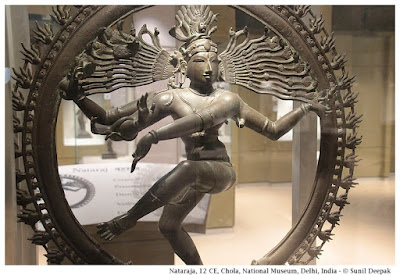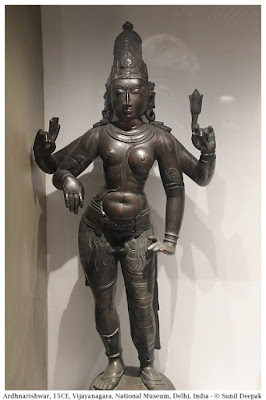After a few decades, recently I was back in the National Museum and was pleasantly surprised by all the changes. Instead of the dusty glass cases holding poorly labelled objects, it has now much better exhibition spaces, similar to some of the better museums in Europe. Thankfully, now you are also allowed to photograph. If you haven't been to National Museum, I recommend visiting it!
Let me start with the image of the delicate and graceful bronze dancing Nataraja sculpture from the 12th century Chola empire, which symbolises destruction and the new creation. Among his flowing hair, on the right side, you can see the river Ganga (Ganges). The centre of his forehead has the third eye, while a snake is wrapped around his right arm.
Let me start with the image of the delicate and graceful bronze dancing Nataraja sculpture from the 12th century Chola empire, which symbolises destruction and the new creation. Among his flowing hair, on the right side, you can see the river Ganga (Ganges). The centre of his forehead has the third eye, while a snake is wrapped around his right arm.
Shiva icons in archaeological section of the national museum
One of the most common representation of Shiv is as Shivling (Shivalinga).
One of the most common representation of Shiv is as Shivling (Shivalinga).
Shivling is
a round or cylindrical form (male principle) placed on a circular base that represents Yoni, the
female principle. While some see it only as a
phallic symbol, for the believers, it has different metaphysical meanings
including a union of Purusha/body and Prakriti/mind. Some people see the trinity itself symbolised in the
Shivling – the circular base represents Brahma, the octagonal stem represents
Vishnu and the round top represents Shiv. Often people may choose a smooth and
round stone from a river bed and worship it as Shivling, these are called
Saligram.
The image below has a very special Shivling - it is Chatturmukhi (four faced) with representations of Brahma, Vishnu, Mahesh (Shiv) and Surya on its four sides. It is from the 6th century Gupta empire period.
Shiva in Harappan culture
The cult of Shiv goes back to much older period in India, during the Middle Stone Age (Middle Palaeolithic). Michael Wood, in “The story of India” has written: “The stone lingam and yoni (male and female principles) – that are found in the worship of Shiva come out of the deep past … These aspects of the indigenous culture of India are part of the givenness of the deep past, which is shared by all Indians, whatever their ancestry, language or religion.”
The cult of Shiv goes back to much older period in India, during the Middle Stone Age (Middle Palaeolithic). Michael Wood, in “The story of India” has written: “The stone lingam and yoni (male and female principles) – that are found in the worship of Shiva come out of the deep past … These aspects of the indigenous culture of India are part of the givenness of the deep past, which is shared by all Indians, whatever their ancestry, language or religion.”
Early Icons
Among the early icons is another Chatturmukhi Shivling - it is from 2nd century CE, when Kushans from central Asia were ruling the Indus valley and parts of north India. It is less well preserved and has a rougher quality. A special feature is the chain motive sculpted on the top third, thus effectively dividing the Shivling into three parts.
Among the early icons is another Chatturmukhi Shivling - it is from 2nd century CE, when Kushans from central Asia were ruling the Indus valley and parts of north India. It is less well preserved and has a rougher quality. A special feature is the chain motive sculpted on the top third, thus effectively dividing the Shivling into three parts.
Another early icon is an Ekmukha (one faced) Shivling, with the head of Shiva (recognised by the third eye in his forehead) on one side. It is from 5th century Gupta period.
Shiv icons in medieval India
The next icon is an Uma-Mahesh sculpture from 9-10 century Pratihara period in north India. Khajuraho was a part of Pratihara empire, before the Chandelas (under the Chandela, the erotic sculptures of Khajuraho were created). This Uma-Mahesh sculpture has a clear erotic/sexual component.
Another representation of Shiv with his consort and family is from 10th century Chalukya period in south India. It touches on sexuality in a different way. In this, Shiv is shown holding a snake in his right hand - snake is seen as a representation of desires and sexuality.
The erotic art of Khajuraho has been seen as a part of Tantrik traditions, in which Shiv and Shakti are together and sexuality is a part of the path for the search of divine. The next image is from 11-12 century Khajuraho under the Chandela period, showing women devotees praying to a Shivling.
Composite icons of Shiv
Shiv is also part of some composite icons. Two examples of these icons from the national museum are presented here.
The first is a Harihar icon, combing Hari (Vishnu) and Har (Shiv). This 12th century statue is from Gahadval in Rajasthan.
The second is an Ardhnarishiwar icon - Ardh (half) Nari (woman) Ishwar (God), representing Shiv and his consort Shakti in the same statue. This 15th century bronze sculpture is from Vijaynagar empire in south India.
Recent icons
Among the more recent icons, there is a striking ivory sculpture from 19th century from South India. It has all the attributes of Shiv - snake, damru (small drum) and the third eye, however the hair style and face seem more similar to representations of Buddha.
Followers of Shiv
Apart from Shiv icons, national museum also has some icons of his more famous followers. The next image presents one of them. It is a bronze statue of saint Manikkavachkar, a Tamil poet from 9th century, famous for his songs about lord Shiv. The sculpture is from 12th century Chola empire in south India.
Conclusions
I love visiting museums and I am glad that I decided to visit the National Museum in Delhi. It is a wonderful place to learn about the rich culture and traditions of India. There is so much to see.
In an article of Devdutt Pattanaik, he had written about the lack of appreciation of the temple art depicting Indic icons among modern Indians and asked, “How many parents actually take their children to museums or to temples and play the game of ‘Let us identify this god’… Our icons have been reduced to ‘property’, possessing them is more important than appreciating them.” I hope that this post will stimulate you to visit national museum and other museums.
I love visiting museums and I am glad that I decided to visit the National Museum in Delhi. It is a wonderful place to learn about the rich culture and traditions of India. There is so much to see.
In an article of Devdutt Pattanaik, he had written about the lack of appreciation of the temple art depicting Indic icons among modern Indians and asked, “How many parents actually take their children to museums or to temples and play the game of ‘Let us identify this god’… Our icons have been reduced to ‘property’, possessing them is more important than appreciating them.” I hope that this post will stimulate you to visit national museum and other museums.
Let me conclude this post with another kind of Shivling - it is called a Lingudhbava, it has Shiv appearing (udbhav) inside the Shivling. This 12th century sculpture is also from Chola empire in south India.
***





















शिव सबसे सरल भगवान लगते हैं. मुझे तो बचपन से परिवार के सदस्य से लगते थे. म्युजिअम देखना अच्छा लगता है. हमारे पीढी ही भगवान की मूर्तियों को पहचानना भूल गयी है.
ReplyDeleteशिव का सरल रूप ही तो भोलेनाथ बाबा है! मेरे विचार में हमारी पीढ़ी को तो फ़िर भी अपने देवी देवताओं के नाम, रूप, गुण मालूम हैं, पर शायद हमारे बाद की पीढ़ियों को यह सब कम मालूम होता है! :)
Delete"A unique take, love it!"
ReplyDeletenarmada shivling